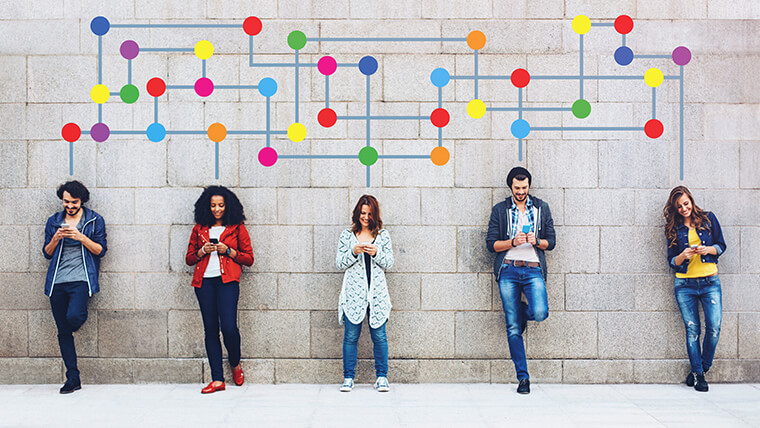The workplace today looks a lot different than it did 20 years ago.
Our teams are often scattered, with some (or all) employees working remotely. We also now have the communication technology to keep people collaborating even when they’re in different countries.
Digital communication is part of our everyday business landscape, now, with chat and text messaging keeping everyone connected on the fly.
An average of 0.4 texts were sent per month in 1995. Today, over 193,000 SMS messages are sent per second.
One side effect of this communication transformation, however, is miscommunication.
Estimates are about $37 billion is lost yearly due to communication barriers, employee misunderstandings, and miscommunication. Things get even more serious in a life-and-death industry like healthcare, where communication failures were linked to 1,744 deaths in five years.
Now, communication barriers at your company might not kill anyone, but they can still cost you.
When you think about it, miscommunication over text-based channels makes perfect sense. A study from UCLA found that the impact of communication is determined 38% by voice quality, 55% by nonverbal communication and a mere 7% by the words used. As we increasingly communicate via chat and text messaging, it’s only natural that misunderstandings would occur.
There are five main reasons those digital-text miscommunications are happening in your business today – and you can do something about it. Read on to find out how to avoid the communication barriers of chat and text.
5 reasons why text and chat can be barriers of communication.
Face-to-face meetings are not a thing of the past. There is still a lot of value in them. But the fact is, not every team can afford to meet face-to-face all the time.
A five-person meeting conducted in-person (involving plane travel for four of the attendees) is over seven times more expensive than a meeting conducted by audio conference, and nearly three times as expensive as a videoconference, according to a study from Verizon.
More and more teams have remote team members, and using digital communication and knowledge management tools to keep everyone connected is now the norm.
Why, though, does text-based communication lend itself more to miscommunication?
There are 5 reasons.
1. Missing context.
In a chat or text message, you don’t have the benefit of the context in which a message was sent.
Is the sender at home, working on a Sunday night when he’s supposed to be having dinner with his family?
Is the person who just sent you a chat message suffering from a cold?
Is she in a noisy office space or airport, and having trouble concentrating on the message she’s writing?
It’s harder to put ourselves in other people’s shoes when we can’t see those shoes.
Some people and teams are more transparent about what’s going on in their lives, and may even use intranet software to share information about themselves, which makes it easier to get some context around text-based communications. But even the most transparent teams risk communication barriers and miscommunication without the full context of being there in the same room.
2. Missing body language.
In text-based communication, body language is nonexistent. You can’t see the sender’s facial expressions, hear their tone of voice, or note (consciously or unconsciously) their posture or other nonverbal communication.
We humans rely a lot on body language to interpret what we’re hearing. The most classic statistic referred to comes from UCLA professor Albert Mehrabian’s studies in the 1960s and states that 93% of all communication is non-verbal. There is some dispute to those figures, but there’s still no doubt that we pay at least equal attention to nonverbal cues as we do to the words being spoken (or texted).
Without the benefit of body language, you run a higher risk of misinterpreting the meaning of communications. You don’t see that wink after a sarcastic statement. You don’t know how to interpret that exclamation point (is it excitement or anger?). You don’t know if a one-word statement of acknowledgement – like “Noted” – means anything more than what it is.
(Side note: For some really interesting facts about body language, check out this article.)
3. Missing emotional content.
The lack of emotional cues can also increase the odds of communication barriers and miscommunication in chat and text messages.
When you’re face-to-face with someone while you’re talking to them, you get a feel for how they interpret your words. You can more quickly see that they respond better to quantitative information, or that they grasp concepts better when they’re communicated through a story or an anecdote.
In text-based communications, eventually you’ll learn each person’s emotional preferences. It just happens much slower, and there’s more trial-and-error involved. Miscommunication is almost a necessity to learn that someone interprets a curt message as angry instead of simply written in a hurry.
And no, emoticons do not effectively replace emotions in chat and text messages.
4. Easier to argue.
The anonymity of text can mean more conflict, too. It’s easier to confront someone whose face you can’t see. It’s easier to let your emotional state color your response when you can’t see the look in someone’s eyes.
Using anonymity as a means to say things you wouldn’t say otherwise isn’t new, however. This didn’t just happen when communication technology came into play. There are examples throughout history of unnamed people criticizing rulers, laws and countries.
“In the early 1660s, in the reign of England’s King Charles II, ‘a printer called John Twyn was put to death for refusing to name the anonymous author of a piece that was critical of [the king]. Throughout history there have been many examples of anonymity being the outlet to criticize repressive or autocratic rulers. Without it, we lose a valuable balance to the powers that be.'” – Brooke Magnanti, quoted in The Wall Street Journal.
In the U.S., “reporter’s privilege” (when a journalist refuses to disclose a source) falls under constitutional law because of this fact. People are a lot less likely to confront others or disclose incriminating information when their name or face might get associated with it.
5. Delay-triggered misunderstandings.
There’s a whole can of worms here in #5. Because digital text communications don’t happen in real time, delays wreak havoc on understanding and create communication barriers.
If you don’t answer back as quickly as the sender expects, they begin to wonder why you’re not responding. They start to tell themselves a story that you’re ignoring them, or you’re mad at them. (And let’s be honest, sometimes we are!)
Having a mobile device gives people the perception that you’re always available – even though logically we all know that’s not the case.
Add to those issues the delay, or “latency,” in which messages are sent and received, and you have a recipe for miscommunication.
When you’re speaking to someone face-to-face, there is no latency. The other person’s response is immediate (even if they don’t speak immediately – remember, we read body language, too!) and directly related to what you just said.
In text-based communications, it may take seconds or much longer for the other person to receive your message. This delay, this latency, may cause the sender to send more messages while they’re awaiting your response to the first. Or anticipating the delay, they may send longer messages to make sure you hear everything they have to say. This makes it difficult for you to address each point individually, and you’re more likely to respond to the whole stream of messages with one blanket reply. Not only can that lead to misinterpretation, but it can leave the message sender feeling unheard.
Help your team avoid communication barriers and miscommunication over chat and text messaging. Download our free best-practices tip-sheet and share it with your whole team to keep everyone on the same page.
The added challenge of an international workforce.
As more companies are hiring remote employees, cultural and language differences are coming up more often in communications, too.
Some cultures value casual lead-ins to text communications, asking how you are and what’s the weather like before getting to their request – which can annoy those coming from cultures that value getting to the point quickly.
Some cultures have strict rules of etiquette regarding everything from who speaks first to the tone in which professional conversations are carried out.
Cultural awareness training is now a part of most enterprise employees’ core curriculum, but it’s fast becoming common in small-to-midsized companies as well. If you have an international workforce, or if your employees interact with international customers, this might be a really smart investment that helps you avoid costly communication barriers and miscommunications.
(For a really deep dive into this topic, I recommend this essay from conflict resolution expert Michelle LeBaron.)
How to avoid communication barriers and miscommunications over chat and text.
Chat and text are easy ways to communicate quickly with people on the other side of the world – or even the other side of the cubicle wall.
As you’ve seen in this article, however, it’s also easy to miscommunicate with these mediums.
I still believe chat and text are important business communication tools, and I won’t try to discourage you from using them. I won’t even tell you to stop and think before you write. What I will encourage you to do, though, is think about the way you’re communicating overall. Whether that’s with teammates, employees or higher-ups.
Here are a few tips I’ve gathered over my many years of using text-based messaging with my teams both near and far.
Keep in mind that the medium is a message.
Text messaging and chat both imply urgency. Especially text messaging. Communicating with these mediums conveys a message in and of itself: “Look at this right now, wherever you are!”
This probably has everything to do with the fact that text messaging and chat reach you with push notifications on your mobile device, which you likely have with you whether you’re at work or in the bathroom, and you assume the sender knows this. You assume that if it wasn’t urgent, they would have sent an email instead.
Remember this when you send a text message or start a chat conversation: It implies urgency. If the message isn’t urgent, either send an email instead or preface your message with “Not urgent” to take some of the pressure off of the recipient.
If the conversation will be a lengthy one, don’t use text or chat.
Text and chat should be used for quick conversations, like this one …
Not for long discussions. It’s too easy to miss important messages in a long thread of back-and-forth text.
Not to mention, it’s easier to keep a record of conversation when it’s done through email, or if you’re taking notes during a phone call or in-person meeting. That way you can be sure you didn’t miss anything, and that you answered (or at least addressed) all the questions that came up.
If a conversation is getting long – or if you anticipate a subject needs a longer discussion – take it off of text and chat. Have a call instead – or better yet, meet up with the person.
Don’t leave people hanging.
Remember, text and chat messages imply urgency. Assume the sender needs a reply quickly (and if you learn they don’t, use this tip-sheet to train them on chat and text messaging best-practices).
If you can’t give the message your full attention or a prompt response, reply with a message like “I’m tied up right now. I’ll get back to you.” Yes, it’s a bit like voicemail that way – and there’s a reason. The message sender is a human being, and we humans like to know we’re being heard. On the phone, people feel heard when they can leave a voicemail. On chat or text, your “I can’t respond right now” message does the same.
The timeliness of your response is an indication of the quality of your relationship, too. When you don’t respond promptly – even if it’s to say you can’t respond right now – without the contextual cues you get from an in-person conversation, the recipient is left wondering if you value them.
But here’s a caveat. When you tell someone you’ll respond later, make sure you follow through and actually get back to them. If you don’t, the sender will lose trust over time, and those “I can’t respond right now” messages won’t mean anything.
If it’s important, pick up the phone.
If the subject is important, don’t do it over chat. Pick up the phone. There’s a lot less chance anything will be miscommunicated or misinterpreted that way.
Don’t make text and chat your main medium for praise, because it won’t mean as much as a phone call or in-person pat on the back. And for heaven’s sake, never reprimand over text or chat. For kudos and warnings, pick up the phone.
If communication barriers and miscommunications will cost you money, time or an employee’s happiness – pick up the phone.
If it’s critical to the success of a project, pick up the phone.
If it will make or break a relationship, pick up the phone.
Stay on topic.
Because text and chat are so quick and easy to use, we have a tendency to send messages rapid-fire. This doesn’t give the other person ample time to answer the previous message, and threads get garbled – fast.
Do yourself a favor and address one topic at a time. Afraid you’re going to forget to say something? Write yourself a note. Or better yet, send an email, pick up the phone or walk over to the person’s desk.
Give people the benefit of the doubt.
Many communication barriers and misinterpretations happen because we doubt the message sender’s intentions. What if you assume, instead, that the message sender was happy when they sent the message?
That would probably clear a lot of things up, I would think.
It’s all too easy to read into a text or chat message – way beyond what the intentions of that message originally were. That’s just human nature. We try to create context where it doesn’t exist, and we lean toward the negative side when creating that context.
Management scholar Kristin Byron believes that misinterpretation comes in two forms: neutral or negative. We tend to dampen positive messages to make them more neutral, and we assume the worst in questionable messages to make them more negative.
This might be human nature, but we do have some control over it. Consciously make a decision to give message senders the benefit of the doubt. Assume they were happy when they sent the message. It’ll save you a lot of grief.
Digital communication empowers your workforce – when it’s used wisely.
Chat and text messaging are connecting teams across the globe. This communication technology is a good thing. We just need to use it wisely to make sure that communication is clear.
Share this tip-sheet of best practices with your team to make sure everyone stays on the same page.




















 info@axerosolutions.com
info@axerosolutions.com 1-855-AXERO-55
1-855-AXERO-55


